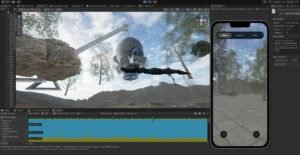Winkler, T. (2000) Audience Participation and Response in Interactive Installation. Available at: https://www.brown.edu/Departments/Music/sites/winkler/research/papers/audience_participation_2000.pdf (Accessed: 6 October 2024).
Hua, M. (2021) Borderlessness: teamLab, Immersive Experience, and New Media Installation Art. OCAD University. Available at: https://openresearch.ocadu.ca/id/eprint/3350/1/Hua_Muxuan_2021_MA_CADN_MRP.pdf (Accessed: 19 September 2024).
Erel, B. (2021) Interactive Art Installation for Togetherness. University of Twente. Available at: https://essay.utwente.nl/88516/1/Erel_BA_EEMCS.pdf (Accessed: 1 Jun 2024).
Research on the Application of Interactive Installation Art in Modern Commercial Space (2023). Available at: https://dl.acm.org/doi/abs/10.1007/978-3-031-34732-0_8 (Accessed: 18 May 2024).
Chen, C.-A., & Lai, H.-I. (2022) ‘Interactive art as reflective experience: Imagineers and ultra-technologists’, Journal of New Media Art. Available at: https://www.tandfonline.com/doi/full/10.1080/01973762.2022.2041218 (Accessed: 26 Apr 2024).
What Makes Interactive Art Engaging? (2022) Frontiers in Computer Science. Available at: https://www.frontiersin.org/journals/computer-science/articles/10.3389/fcomp.2022.859496/full (Accessed: 7 Jun 2024).
Grau, O., ed. (2007) Media Art Histories. MIT Press.
Dixon, S. (2007) Digital Performance: A History of New Media in Theater, Dance, Performance Art, and Installation. MIT Press.
Popoli, Z., & Derda, I. (2020) ‘Digital Storytelling in Immersive Exhibitions’, Journal of Virtual Reality.
Overbeeke, K.C.J., et al. (2003) ‘Designing Engaging Interactive Systems’, Interacting with Computers.
GitHub. (n.d.). *ticahere/ll_virtual_gallery*. Available at: https://github.com/ticahere/ll_virtual_gallery [Accessed 13 May. 2024].
MacKenzie Art Gallery. (2020). *Virtual Art Galleries*. Available at: https://mackenzie.art/digital-art/learn-about-digital-art/virtual-art-galleries/ [Accessed 6 Nov. 2024].
Hill, R. (2020). *Building a Virtual Gallery in Unity3D*. Dunlop Art Gallery.
Peart, W., & Hill, E. (2020). *The Virtual White Cube: Challenges and Opportunities in Digital Exhibitions*. MacKenzie Art Gallery.
O’Brien-Davis, L., & Doherty, S.J. (2020). *What is New Media Art? Exploring Themes and Technologies*. MacKenzie Art Gallery.
Holland, F., & Sandals, L. (2020). *Digital Exhibitions: Navigating the New Normal in Art Presentation*. Canadian Art.
DAiR v1 Exhibition Team. (2021). *Video Games by Artists*. Saskatchewan Artists.
Scherotter, M. (2021). *Creating Virtual Exhibitions with Babylon JS*. Babylon JS Forum.
Fitzpatrick, E., & Hill, R. (2020). *Interactive 3D Spaces in Unity: A Workshop Overview*. Dunlop Art Gallery.
Vour Team. (n.d.). *Vour – Virtual Tour Creation Tool Documentation*. Available at: https://crizgames.github.io/VourDemo/ [Accessed 6 Nov. 2024].
Sandals, L., & Holland, F. (2020). *WellNowWTF? Online Exhibition Tour*. Canadian Art.
Pure Ref Team. (n.d.). *Image Viewer for Artists and Designers*. Artist Lounge.
LearnSpace Records. (n.d.). *Music for Virtual Galleries*. Available at: https://bit.ly/3goo7XX [Accessed 15 May. 2024].
NewArt.City Team. (n.d.). *Virtual Exhibitions Platform Overview*. Available at: https://newart.city/ [Accessed 12 Jun. 2024].
 Heninn is an immersive virtual gallery app built with Unity, showcasing diverse digital art projects, including Weifangese Cadence. The app transcends physical boundaries, enabling users to explore Huiqun Xu’s work in a fully interactive 3D environment. Heninn emphasizes spatial engagement, allowing users to navigate and examine art as if in a physical gallery, aligning with modern exhibition trends that prioritize interactivity and user agency. This approach is consistent with the concept of “borderlessness” in interactive installation art, which aims to dissolve the physical boundaries between the viewer and the artwork, creating an immersive experience that extends beyond traditional visual engagement.
Heninn is an immersive virtual gallery app built with Unity, showcasing diverse digital art projects, including Weifangese Cadence. The app transcends physical boundaries, enabling users to explore Huiqun Xu’s work in a fully interactive 3D environment. Heninn emphasizes spatial engagement, allowing users to navigate and examine art as if in a physical gallery, aligning with modern exhibition trends that prioritize interactivity and user agency. This approach is consistent with the concept of “borderlessness” in interactive installation art, which aims to dissolve the physical boundaries between the viewer and the artwork, creating an immersive experience that extends beyond traditional visual engagement.

 Leveraging Unity’s 3D rendering and cloud-based storage, Heninn provides a dynamic, updateable platform. Its architecture supports future VR integration, making it a valuable research tool for studying spatial interaction in digital art. This aligns with current research on the impact of extended reality technologies on exhibition spaces, which highlights how these technologies transform visitor experiences by merging real and virtual environments. Designed for students, researchers, and digital media practitioners, Heninn offers insights into the potential of virtual spaces to enhance art engagement. It serves as a model for interactive digital exhibitions that redefine aesthetic experiences in the virtual realm by integrating relational aesthetics with digital interactivity.
Leveraging Unity’s 3D rendering and cloud-based storage, Heninn provides a dynamic, updateable platform. Its architecture supports future VR integration, making it a valuable research tool for studying spatial interaction in digital art. This aligns with current research on the impact of extended reality technologies on exhibition spaces, which highlights how these technologies transform visitor experiences by merging real and virtual environments. Designed for students, researchers, and digital media practitioners, Heninn offers insights into the potential of virtual spaces to enhance art engagement. It serves as a model for interactive digital exhibitions that redefine aesthetic experiences in the virtual realm by integrating relational aesthetics with digital interactivity.

